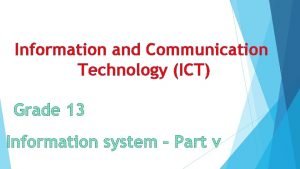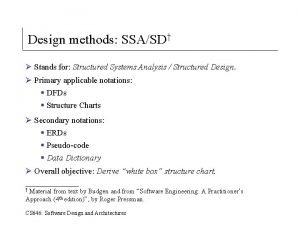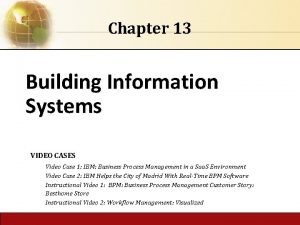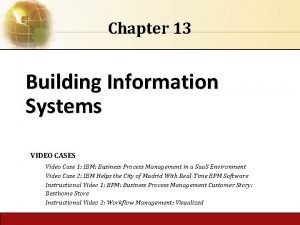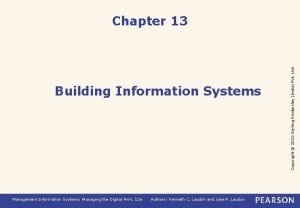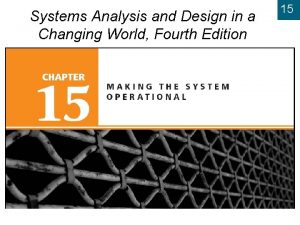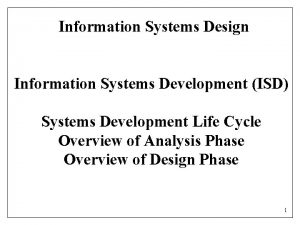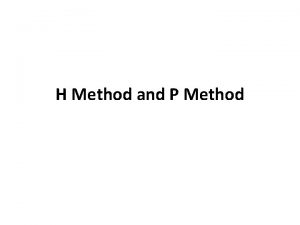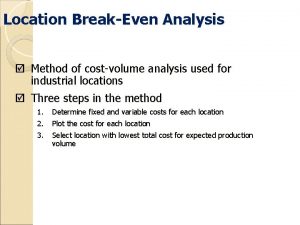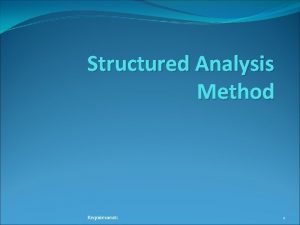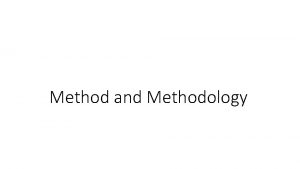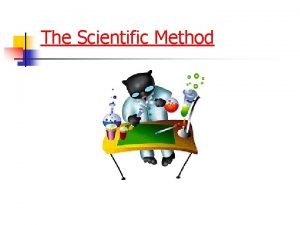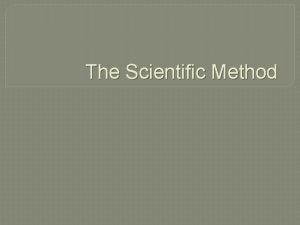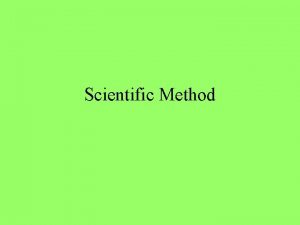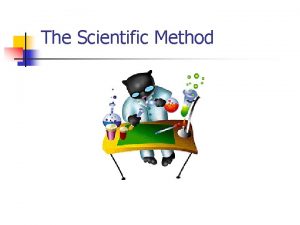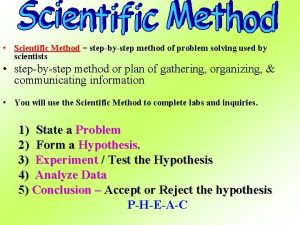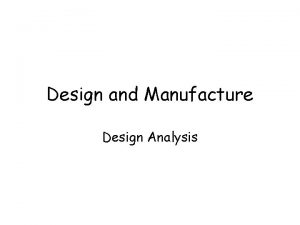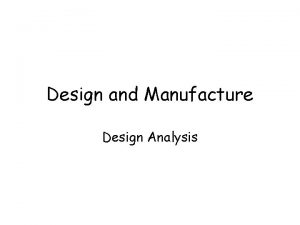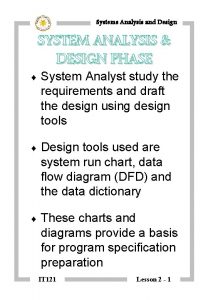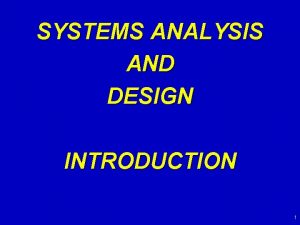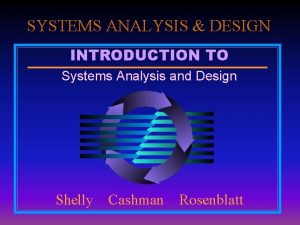Information Systems Analysis and Design A method used






























- Slides: 30

Information Systems Analysis and Design A method used by companies to create and maintain systems that perform basic business functions Main goal is to improve employee efficiency by applying software solutions to key business tasks

Information Systems Analysis and Design Systems Analyst performs analysis and design based upon: n n Understanding of organization’s objectives, structure and processes A structured approach, in order to ensure success

SDLC

Systems Analysis and Design: Core Concepts System: Turns data into information and includes: n n n Hardware and system software Documentation and training materials Job roles associated with the system Controls to prevent theft or fraud The people who use the software to perform their jobs

Characteristics of a System Components or subsystems Interrelated Components Boundary Purpose External environment Interfaces (between subsystems or system & environment) Constraints or limits Input Output

Software Engineering Process A process used to create an information system Consists of: n Methodologies w A sequence of step-by-step approaches that help develop the information system n Techniques w Processes that the analyst follows to ensure thorough, complete and comprehensive analysis and design n Tools w Computer programs that aid in applying techniques

Important System Concepts Decomposition n The process of breaking down a system into smaller components Modularity n Process of dividing a system into modules of uniform size to simplify system design Coupling n Subsystems that are dependent upon each other are coupled Cohesion n Extent to which a subsystem performs a single function

A Modern Approach to Systems Analysis and Design Systems Integration n Allows hardware and software from different vendors to work together. Enables procedural language systems to work with visual programming systems Visual programming environment uses client/server model

Client/Server Model

Information Systems Architecture Data n Data & Information (What? ) Process n Application Programs (How? ) Network n System configuration (Where? )

Components of an IS Data n describe data and the relationship amongst data Processing Logic n Describe steps that transform data and events that trigger the steps Data Flows n describe the sources and destination for each data flow

Data & Processes

Approaches to Systems Development Process-Oriented Approach n n n Focus is on flow, use and transformation of data in an information system Involves creating graphical representations such as data flow diagrams and charts Data are tracked from sources, through intermediate steps and to final destinations Natural structure of data is not specified Disadvantage: data files are tied to specific applications

Database Approach

Approaches to Systems Development Data-Oriented Approach n n n Depicts ideal organization of data, independent of where and how data are used Data model describes kinds of data and business relationships among the data Business rules depict how organization captures and processes the data

Key Differences Characteristic Process-Oriented Data-oriented System focus What the system needs to do & when Limited Design stability Data the system needs to operate More enduring Data organization Data files designed for each designed for the individual enterprise application State of the Data Much uncontrolled duplication Limited controlled redundancy

Databases and Application Independence Database n n Shared collection of logically related data Organized to facilitate capture, storage and retrieval by multiple users Centrally managed Designed around subjects w Customers w Suppliers Application Independence n Separation of data and definition of data from applications

Role of the Systems Analyst Study problems and needs of an organization Determine best approach to improving organization through use of: n n n People Methods Information technology Help system users and managers define their requirements for new or enhanced systems

Types of Information Systems and Systems Development Transaction Processing Systems (TPS) n Automate handling of data about business activities (transactions) Management Information Systems (MIS) n Converts raw data from transaction processing system into meaningful form

Types of Information Systems and Systems Development Decision Support Systems (DSS) n n Designed to help decision makers Provides interactive environment for decision making Expert Systems (ES) n n Replicates decision making process Knowledge representation describes the way an expert would approach the problem

Systems Development IS type IS Characteristics Development Methods TPS High volume, data capture focus Process orientation MIS Aggregates & summarizes diverse data sources DSS Accesses data at different levels Data and decision of detail to select and compare logic orientation alternative solutions to problems (Prototyping & RAD) ES Provides expert advice Data orientation Specialized decision logic orientation

Systems Development Life Cycle Series of steps used to manage the phases of development for an information system Consists of four phases: n n Planning and Selection Analysis Design Implementation and Operation

Phases & Products of SDLC Systems Planning and Selection n Two Main Activities w Identification of need w Investigation and determination of scope n Deliverables w Priorities for systems and projects w Architecture for data, network, hardware and IS management w Detailed steps (work plan) for project w Specification of system scope w System justification (business case)

Phases & Products of SDLC Systems Analysis n Study of current procedures and information systems w w n Determine requirements Generate alternative designs Compare alternatives Recommend best alternative Deliverables w Description of current systems (problems/opportunities) w Recommendation on how to fix/enhance/replace current systems w Explanation of alternatives and justification of chosen system

Phases & Products of SDLC System Design n Logical Design w Concentrates on business aspects of the system n Physical Design w Technical specifications n Deliverables w Detailed specifications of system elements w Acquisition plan for new technology

Phases & Products of SDLC Implementation and Operation n Implementation w w n Hardware and software installation Programming User Training Documentation Operation w System changed to reflect changing conditions. w System obsolescence n Deliverables w Code & documentation w Training procedures w New versions/releases of software

New Development Methodologies Rapid Application Development (RAD) n Utilizes prototyping to delay producing system design until after user requirements are clear Prototyping n n Building a scaled-down working version of the system Advantages: w Users are involved in design w Captures requirements in concrete form

Prototyping

Selecting a Methodology System Structured Spiral RAD Characteristics Unclear Poor Excellent Good requirements Prototyping Unfamiliar technology Complex Poor Excellent Good Poor Good Excellent Good Poor Reliable Good Excellent Good Poor Short time schedule Poor Good Excellent

Approaches to Development Joint Application Design (JAD) n n n Users, Managers and Analysts work together for several days System requirements are reviewed Structured meetings Participatory Design
 Structured system analysis and design
Structured system analysis and design Ssadm diagram
Ssadm diagram Ssadm model
Ssadm model List the five basic steps of ssa/sd process
List the five basic steps of ssa/sd process When to use sdlc
When to use sdlc The oldest method for building information systems is
The oldest method for building information systems is The oldest method for building information systems is:
The oldest method for building information systems is: The oldest method for building information systems is:
The oldest method for building information systems is: Systems analysis & design in an age of options
Systems analysis & design in an age of options Gantt chart system analysis and design
Gantt chart system analysis and design Systems analysis and design in a changing world
Systems analysis and design in a changing world System analysis and design in a changing world
System analysis and design in a changing world System analysis and design alan dennis
System analysis and design alan dennis Introduction to systems analysis and design
Introduction to systems analysis and design Case tools are limited to systems analysis.
Case tools are limited to systems analysis. Modern systems analysis and design
Modern systems analysis and design Kendall and kendall system analysis and design
Kendall and kendall system analysis and design Alan dennis system analysis design
Alan dennis system analysis design Systems analysis and design alan dennis
Systems analysis and design alan dennis Systems analysis and design alan dennis
Systems analysis and design alan dennis Systems analysis and design alan dennis
Systems analysis and design alan dennis Systems analysis and design alan dennis
Systems analysis and design alan dennis Systems analysis and design alan dennis
Systems analysis and design alan dennis Systems analysis and design alan dennis
Systems analysis and design alan dennis Radar systems analysis and design using matlab
Radar systems analysis and design using matlab Object-oriented systems analysis and design using uml
Object-oriented systems analysis and design using uml A modern approach to systems analysis and design
A modern approach to systems analysis and design Patched up prototype
Patched up prototype System analysis and design in a changing world
System analysis and design in a changing world Systems analysis and design in a changing world
Systems analysis and design in a changing world Systems analysis and design in a changing world
Systems analysis and design in a changing world


